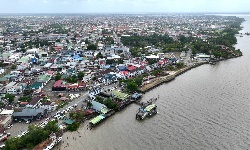YinYuzhen was just 20 when she married and moved from Shaanxi province to her newhome in Inner Mongolia, which she was shocked to discover was a cave dwellingin the desert.
Hernew home was located in Erlinchuan village, Uxin Banner, Ordos in northernInner Mongolia. It was a cave dug out halfway down a sand slope, half buried insand. Yin had to bend over to enter the cave, where the floor was laid withgrass and deadwood. She was surrounded by nothing but sand and silence.
Everyday, when the wind stopped, the whole family would have to shovel the sand thathad gathered in front of the door, so that the house would not be buried. Itwas 1985 and they lived in extreme poverty.
However,30 years later, the 4,667-hectare desert area she calls home has now become agreen landscape, where a wide variety of trees stand and wild roosters, rabbitsand foxes live.
Yinnow runs her own company, an ecological garden with a 400-square-meter officespace to manage the forest and a seedling breeding center. In the 1,000 sq mdining hall, people can taste the fruit and vegetables grown in her ecologicalgarden, including watermelons, pears and corn.
However,the battle against poverty was filled with challenges.
Shegave a birth prematurely to her first son and lost her second baby afterfalling down when carrying trees from the town to the desert. Yin and herhusband took laboring jobs in Dongkeng, 6 kilometers away from their home,asking for no salary but just to be paid in saplings, as an exchange of labor.
Atthat time, the local government gave saplings to the villagers to encouragethem to plant trees. However, not many people took it seriously. But Yin said:"I would rather die from exhaustion planting trees than being bullied bythe desert."
Becausethere was no road or car to transport the saplings from the town to the desert,they had to carry them on their backs, even when Yin was pregnant.
"Wecouldn't miss the best season of planting," she said. "I didn't wantmy children to suffer, so I had to continue."
Withouttechnology or knowledge, most of their trees died quickly.
Amongthe first 600 saplings, only 10 survived.
Later,she learnt to stabilize the quicksand first with a plant named sand sagebrush.She planted other plants such as sand willow and mongolicum.
Theproportion of plants that survived grew and areas of green formed in the barrenarea.
Yearslater, she applied seedling technology and increased the survival rate to about80 percent, helping to save costs.
Tosolve the problem of transportation, she hired a team of 10 people to constructa road to connect her home to the outside world. It was built with grass, driedbranches and soil.
"Onlyif you have endured poverty can you understand how difficult it is to do thingswithout much money," she said. "Desertification control can be abottomless hole, and I had to figure out how to get money if I were to continueplanting trees."
Thisentrepreneur later discovered a more efficient plant, Mongolian pine, so shenurtured 8 hectares of saplings at her base, and then planted the trees over667 hectares of desert.
Yinwas nominated for a Nobel Peace Prize in 2005 and won first prize at the 2010Women and Desertification Conference held in South Korea.






